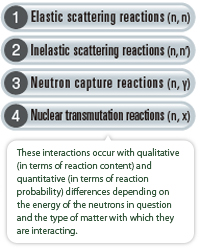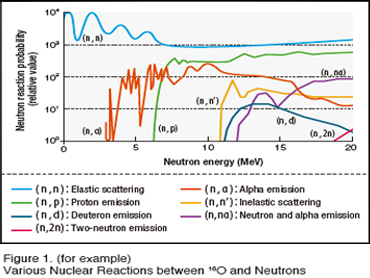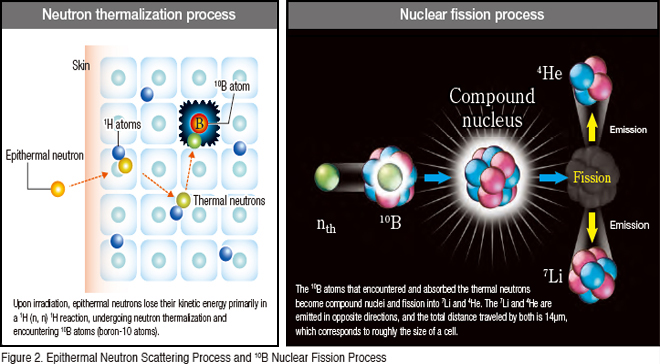Neutron capture reaction
Neutron capture reaction
Neutrons and their characteristics
 Neutrons are electrically neutral subatomic particles (that is, they have no electrical charge). When existing alone in a vacuum, neutrons decay into a proton and an electron at a half-life of 10.8 minutes. All of the atomic nuclei are composed of neutrons and protons, which are usually approximately equal in number, although there can be up to a 30% difference. The mass of a neutron is nearly equal to that of a proton (the differences between those are about 0.108 %). Depending on their particular combination of nuclear particles, atomic nuclei are either stable (giving rise to a stable isotope [SI]) or unstable (giving rise to a radioisotope [RI]).
Neutrons are electrically neutral subatomic particles (that is, they have no electrical charge). When existing alone in a vacuum, neutrons decay into a proton and an electron at a half-life of 10.8 minutes. All of the atomic nuclei are composed of neutrons and protons, which are usually approximately equal in number, although there can be up to a 30% difference. The mass of a neutron is nearly equal to that of a proton (the differences between those are about 0.108 %). Depending on their particular combination of nuclear particles, atomic nuclei are either stable (giving rise to a stable isotope [SI]) or unstable (giving rise to a radioisotope [RI]).
Neutrons can be characterized by the manner in which they interact with other types of matter. The interactions of neutrons at or below 20 to 30 MeV, the range of energy levels that are used in medical treatment, can be classified using the following conceptual categories:
 As illustrated in Figure 1, a variety of reactions occur depending on the energy of the neutrons in question. Consequently, fields where there are neutrons exhibit an extremely diverse range of radiation. In addition to the epithermal neutrons that play the central role in BNCT, tissues in the bodies of patients placed in the BNCT irradiation field are exposed to radiation that has leaked from treatment equipment and radiation given off by neutrons.
As illustrated in Figure 1, a variety of reactions occur depending on the energy of the neutrons in question. Consequently, fields where there are neutrons exhibit an extremely diverse range of radiation. In addition to the epithermal neutrons that play the central role in BNCT, tissues in the bodies of patients placed in the BNCT irradiation field are exposed to radiation that has leaked from treatment equipment and radiation given off by neutrons.
Let’s take a closer look at the following reactions while paying special attention to their relationships with BNCT:
【1】Elastic scattering reactions (n, n)
Elastic scattering refers to a scattering phenomenon involving neutrons and atomic nuclei in which momentum and kinetic energy are conserved. These reactions include potential scattering and resonance scattering, in which compound nuclei are formed. In the case of the latter, the wave character of the neutrons, based on the de Broglie wavelength, is involved in causing a resonant reaction. This reaction is dominant for many elements with neutrons at or below 10 MeV. Although elastic scattering reactions with hydrogen are primarily used in fast neutron therapy, this reaction is undesirable in BNCT since it is mostly unrelated to 10B concentrations and has similar effects on tumor tissue and healthy tissue.
【2】Inelastic scattering reactions(n, n’)
Unlike inelastic scattering reactions, colliding neutrons are absorbed by atomic nuclei in neutron capture reactions. Consequently, each nucleus becomes an isotope with a mass number that is one greater. In most elements, the binding energy of nuclear particles is about 8 MeV. The formed nuclei enter an excited state of about that level of energy, which then decays upon emitting gamma rays
【3】Neutron capture reactions (n,y)
Unlike inelastic scattering reactions, colliding neutrons are absorbed by atomic nuclei in neutron capture reactions. Consequently, each nucleus becomes an isotope with a mass number that is one greater. In most elements, the binding energy of nuclear particles is about 8 MeV. The formed nuclei enter an excited state of about that level of energy, which then decays upon emitting gamma rays according to the excitation level. This reaction involves only the emission of gamma rays and is not desirable for BNCT, but it is used as a technique for prompt gamma-ray analysis (PGA) since 10B concentrations in blood or other biological specimens must be measured to obtain basic data for treatment. This reaction can also be described as one type of nuclear transmutation reaction (4).
【4】Nuclear transmutation reactions (n, x)
In a nuclear transmutation reaction, of which they are a variety of types, a compound nucleus formed by colliding neutrons and an isotope is split into a combination of isotopes that differ from the pre-reaction state. Of these, the most important reactions for BNCT are 10B (n, α) 7Li and 14N (n, p) 14C.
It is from the former that the name for BNCT is derived. Figure 2 diagrams the process by which the epithermal neutrons that are used in BNCT, which have energy of about 0.5 eV to 40 keV (the typical energy of a thermal neutron is 0.0254 eV), are irradiated, encounter boron-10 (10B) in the body, and decay into 7Li while emitting alpha particles.
The latter reaction of 14N (n, p) 14C gives off protons with energy of 0.58 MeV, which gives them a high cell-killing potential. Since large numbers of nitrogen atoms are present in both tumor cells and healthy cells, the reaction has a not insignificant impact on both. In particular, it is important to emphasize this latter reaction for its relationship with the development of issues (complications) in normal tissue.
